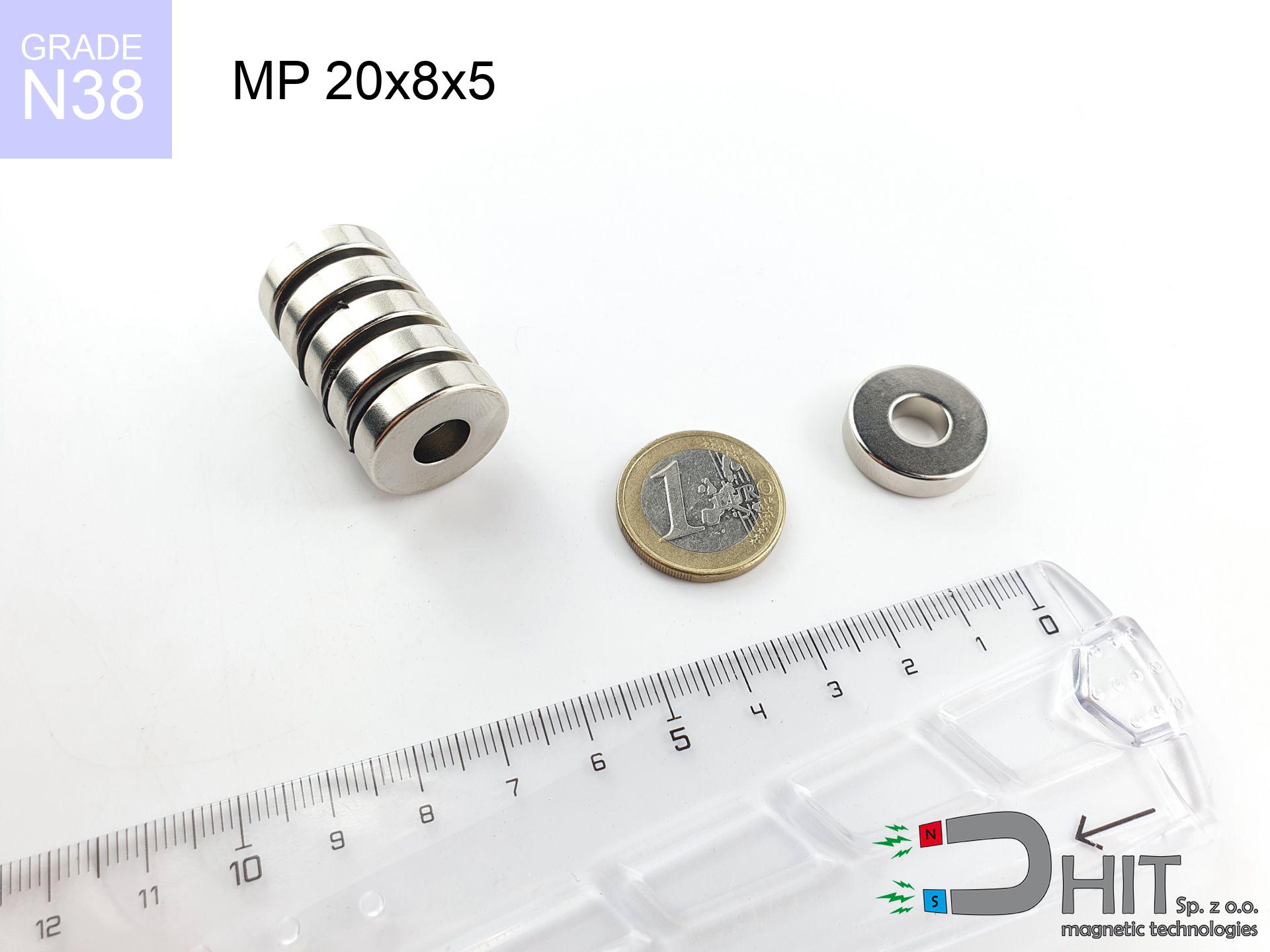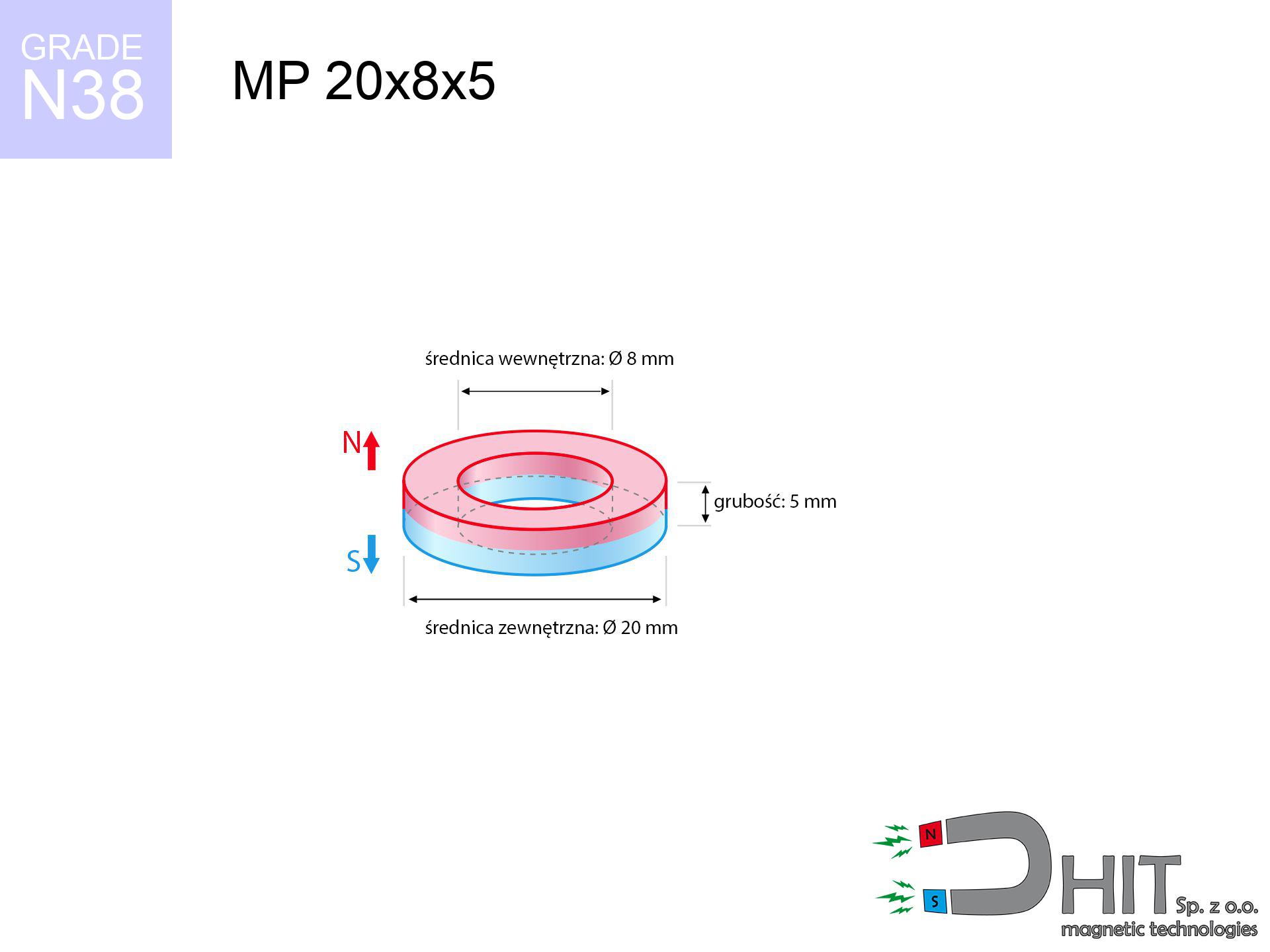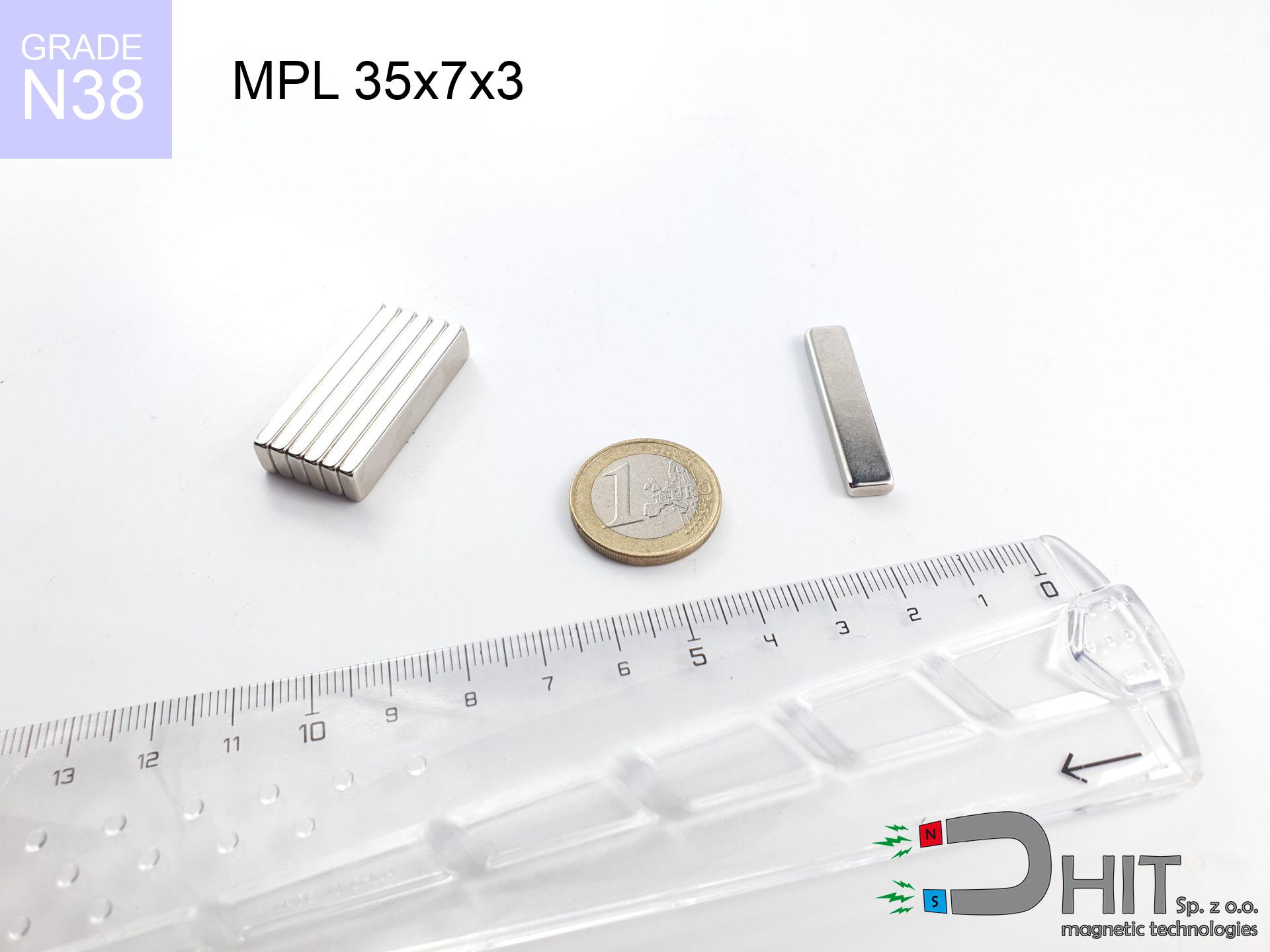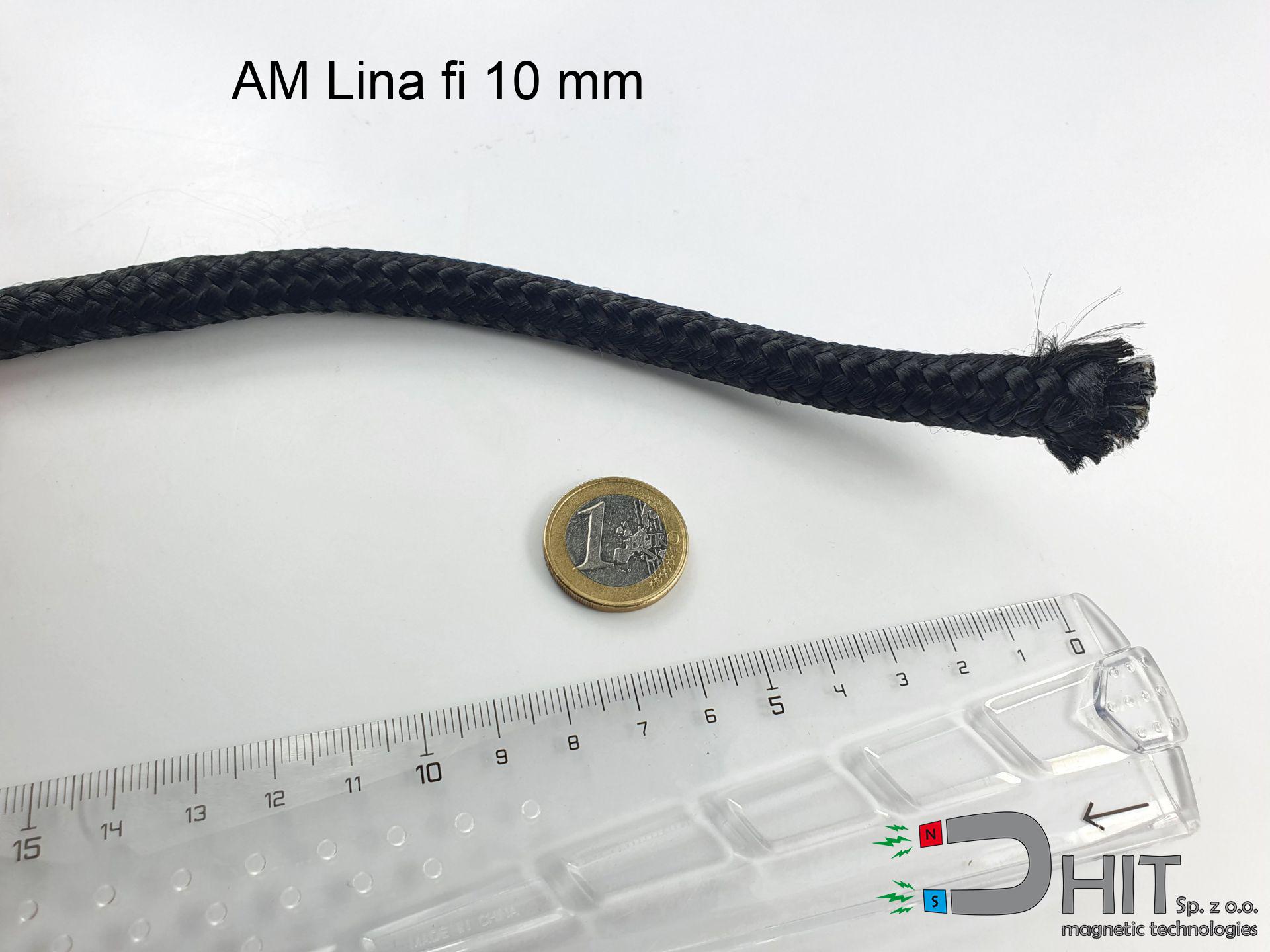MP 20x8x5 / N38 - ring magnet
ring magnet
Catalog no 030188
GTIN: 5906301812050
Diameter
20 mm [±0,1 mm]
internal diameter Ø
8 mm [±0,1 mm]
Height
5 mm [±0,1 mm]
Weight
14.14 g
Magnetization Direction
↑ axial
Load capacity
2.28 kg / 22.36 N
Magnetic Induction
206.25 mT
Coating
[NiCuNi] nickel
3.80 ZŁ with VAT / pcs + price for transport
3.09 ZŁ net + 23% VAT / pcs
bulk discounts:
Need more?Do you have a dilemma?
Contact us by phone
+48 888 99 98 98
if you prefer drop us a message via
contact form
the contact section.
Weight and structure of magnetic components can be tested using our
magnetic calculator.
Same-day processing for orders placed before 14:00.
Magnetic properties of material N38
Physical properties of sintered neodymium magnets Nd2Fe14B at 20°C
Shopping tips
Strengths and weaknesses of rare earth magnets.
Apart from their superior holding force, neodymium magnets have these key benefits:
- They have stable power, and over nearly ten years their performance decreases symbolically – ~1% (in testing),
- They are resistant to demagnetization induced by external field influence,
- By covering with a shiny coating of silver, the element acquires an aesthetic look,
- Neodymium magnets ensure maximum magnetic induction on a their surface, which allows for strong attraction,
- Neodymium magnets are characterized by extremely high magnetic induction on the magnet surface and can work (depending on the shape) even at a temperature of 230°C or more...
- Thanks to versatility in forming and the ability to modify to client solutions,
- Universal use in future technologies – they are utilized in data components, drive modules, medical equipment, also other advanced devices.
- Thanks to efficiency per cm³, small magnets offer high operating force, in miniature format,
Drawbacks and weaknesses of neodymium magnets: weaknesses and usage proposals
- Brittleness is one of their disadvantages. Upon strong impact they can fracture. We advise keeping them in a strong case, which not only protects them against impacts but also increases their durability
- When exposed to high temperature, neodymium magnets experience a drop in force. Often, when the temperature exceeds 80°C, their strength decreases (depending on the size, as well as shape of the magnet). For those who need magnets for extreme conditions, we offer [AH] versions withstanding up to 230°C
- They oxidize in a humid environment. For use outdoors we suggest using waterproof magnets e.g. in rubber, plastic
- Due to limitations in producing threads and complex forms in magnets, we recommend using cover - magnetic mount.
- Potential hazard related to microscopic parts of magnets are risky, if swallowed, which gains importance in the context of child safety. Furthermore, tiny parts of these products can be problematic in diagnostics medical when they are in the body.
- Higher cost of purchase is a significant factor to consider compared to ceramic magnets, especially in budget applications
Breakaway strength of the magnet in ideal conditions – what it depends on?
The declared magnet strength refers to the maximum value, recorded under optimal environment, meaning:
- using a plate made of high-permeability steel, acting as a circuit closing element
- possessing a thickness of min. 10 mm to avoid saturation
- with a surface cleaned and smooth
- with total lack of distance (no paint)
- for force acting at a right angle (in the magnet axis)
- at ambient temperature room level
Determinants of lifting force in real conditions
Holding efficiency is affected by working environment parameters, mainly (from priority):
- Distance (betwixt the magnet and the plate), since even a very small distance (e.g. 0.5 mm) results in a reduction in force by up to 50% (this also applies to varnish, corrosion or dirt).
- Angle of force application – highest force is available only during pulling at a 90° angle. The resistance to sliding of the magnet along the surface is typically several times lower (approx. 1/5 of the lifting capacity).
- Plate thickness – insufficiently thick plate does not accept the full field, causing part of the power to be wasted into the air.
- Plate material – low-carbon steel gives the best results. Alloy steels decrease magnetic permeability and holding force.
- Plate texture – ground elements ensure maximum contact, which improves force. Rough surfaces weaken the grip.
- Thermal factor – hot environment reduces magnetic field. Too high temperature can permanently damage the magnet.
* Lifting capacity testing was conducted on a smooth plate of optimal thickness, under perpendicular forces, however under shearing force the holding force is lower. Additionally, even a minimal clearance {between} the magnet’s surface and the plate decreases the holding force.
Safety rules for work with NdFeB magnets
Demagnetization risk
Control the heat. Heating the magnet to high heat will destroy its properties and pulling force.
Mechanical processing
Dust generated during grinding of magnets is self-igniting. Avoid drilling into magnets without proper cooling and knowledge.
Medical implants
Life threat: Strong magnets can deactivate pacemakers and defibrillators. Stay away if you have medical devices.
Protect data
Do not bring magnets close to a wallet, laptop, or TV. The magnetism can destroy these devices and erase data from cards.
Do not underestimate power
Handle magnets with awareness. Their huge power can shock even experienced users. Be vigilant and do not underestimate their power.
Fragile material
NdFeB magnets are sintered ceramics, which means they are fragile like glass. Clashing of two magnets will cause them breaking into small pieces.
Allergic reactions
Medical facts indicate that the nickel plating (standard magnet coating) is a common allergen. For allergy sufferers, prevent touching magnets with bare hands and opt for versions in plastic housing.
Compass and GPS
A powerful magnetic field interferes with the functioning of magnetometers in smartphones and GPS navigation. Do not bring magnets near a smartphone to prevent damaging the sensors.
Bone fractures
Pinching hazard: The pulling power is so great that it can cause hematomas, pinching, and even bone fractures. Protective gloves are recommended.
Choking Hazard
Absolutely keep magnets away from children. Choking hazard is high, and the effects of magnets connecting inside the body are fatal.
Caution!
Learn more about hazards in the article: Safety of working with magnets.






![SM 25x125 [2xM8] / N42 - magnetic separator SM 25x125 [2xM8] / N42 - magnetic separator](https://cdn3.dhit.pl/graphics/products/sm-25x125-2xm8-duj.jpg)


